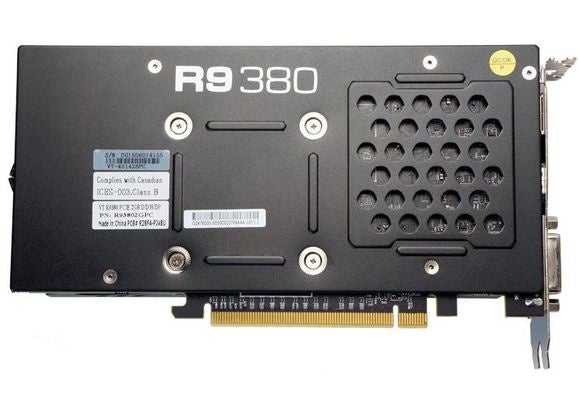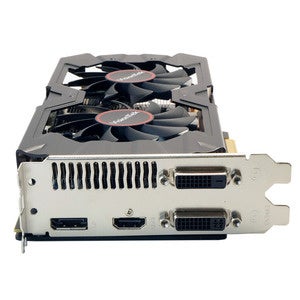Strict Standards: Only variables should be assigned by reference in /home/noahjames7/public_html/modules/mod_flexi_customcode/tmpl/default.php on line 24
Strict Standards: Non-static method modFlexiCustomCode::parsePHPviaFile() should not be called statically in /home/noahjames7/public_html/modules/mod_flexi_customcode/tmpl/default.php on line 54
Strict Standards: Only variables should be assigned by reference in /home/noahjames7/public_html/components/com_grid/GridBuilder.php on line 29
The battle for PC gaming’s sweet spot is on.
The $150 to $200 price range is crucial for AMD, Nvidia, and all of their assorted partners. The overwhelming majority of graphics cards sold cost less than $200, with cards in that price range delivering a solid 1080p experience in modern games—and over 50 percent off all PC gamers rock 720p or 1080p displays, according to the Steam hardware survey. Mainstream graphics cards are a big deal.
Case in point: Just last month, Nvidia released a new GeForce GTX 950 graphics card in order to snatch the $150 crown away from AMD’s Radeon R7 370. That prompted AMD to release a more powerful R9 370X in some parts of the world.
The tables turn when you hit the $200 mark. First revealed at E3, the Radeon R9 380’s “Tonga” graphics processor is the same one found in the R9 285, which first launched in August 2014. But don’t let the rehashed GPU dissuade you: The Radeon R9 380 is loaded with support for AMD’s newest features and delivers the best raw performance you can find for $200 today, surpassing Nvidia’s $200 GeForce GTX 960—albeit at the expense of much higher power usage.

VisionTek’s Radeon R9 380 backplate.
Meet the new mainstream 1080p champion. Let’s dig in.
Inside the Radeon R9 380
You won’t find much new inside the R9 380 that wasn’t already available in the R9 285. Glancing over the spec sheet below, the only noticeable difference between the two is that the max clock speed was nudged up from 918MHz in the R9 285 to 970MHz in the “new” R9 380. The memory speed also received a borderline-negligible 100MHz bump.

Tech specs for the entire Radeon R300 series family.
Because of that, we won’t spend much time detailing the Radeon R9 380’s deepest, darkest details—just check the chart above if you're interested. It’s available in models with 2GB or 4GB of memory, and since the Tonga GPU is still relatively new—August 2014 wasn’t that long ago—the R9 380 packs full support for DirectX 12 and helpful AMD features like FreeSync, Virtual Super Resolution, and Frame Rate Target Control, unlike the $150-and-up Radeon R7 370, which is based on a GPU from 2012.

The VisionTek Radeon R9 380’s port selection.
VisionTek kindly sent us one of its 2GB R9 380s for testing, and you couldn’t ask for a better representative. The VisionTek Radeon R9 380 sticks to stock specs from clock speeds to memory configuration, but spruces things up with a nice dual-fan custom cooling solution featuring a card-length heat sink and copper heat pipes. Those heat sink fins run across the length of the card to help vent heat out of the rear more easily, a design feature that AMD itself recently crowed about when introducing the Radeon R9 Nano.
A rigid, black metal backplate—shown above, in the intro—is another nice touch, as is VisionTek’s limited lifetime warranty on the card if you register it within 30 days of purchase. That drops to one year if you don’t register, though.
Connectivity-wise, the VisionTek Radeon R9 380 offers DVI-D, DVI-I, HDMI 1.4a, and DisplayPort, the last of which is a must-have if you’re thinking of investing in a FreeSync monitor to make your PC games super-smooth.
AMD Radeon R9 380 benchmark tests
As ever, we tested the VisionTek Radeon R9 380 on PCWorld’s dedicated graphics card benchmark system. Here are the relevant tidbits:
Our DIY build guide for the machine has every nitty-gritty detail about it if you’re thirsting for even more detail.
Next page: Gaming benchmarks begin.
Strict Standards: Only variables should be assigned by reference in /home/noahjames7/public_html/modules/mod_flexi_customcode/tmpl/default.php on line 24
Strict Standards: Non-static method modFlexiCustomCode::parsePHPviaFile() should not be called statically in /home/noahjames7/public_html/modules/mod_flexi_customcode/tmpl/default.php on line 54
Find out more by searching for it!
